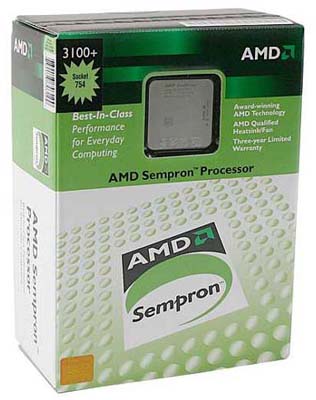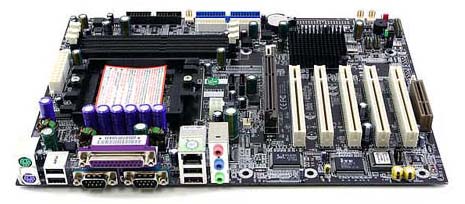Buyer's Guide - Entry Level, October 2004
by Jarred Walton on October 6, 2004 12:05 AM EST- Posted in
- Guides
CPU and Motherboard: Budget Gaming
Very few applications can stress a processor as much as a game, so we recommend that anyone with an interest in the hobby plan to spend more money. Some might even go so far as to say that the words "budget" and "gaming" do not belong in the same sentence, but we feel that budget gaming is possible - you just have to increase funding by a little. If you can cut down on those fast food trips and eat ramen noodles for a month, you should be able to afford a decent gaming system.
Gaming CPU: AMD Sempron 3100+ 256K 1.8 GHz 400 MHz bus
Price: $120 shipped (Retail)
In order to help you get your gaming fix, we have moved from socket A to socket 754 for our CPU and motherboard recommendation, and the Athlon XP has finally been replaced by the Sempron 3100+. For a price increase of roughly 25% over the Athlon XP 2500+, performance is increased by a similar amount. In addition to the increased performance, the newer socket 754 platform should allow for more upgrades in the future as they become necessary.
Socket 754 was previously the domain of the 64-bit Athlon 64. However, in order to cut costs and avoid cannibalizing sales of their premium processors, AMD has reduced the amount of cache to 256K and disabled the 64-bit extensions. These omissions do not affect performance as much as they might on another platform, though, since the integrated memory controller remains and 64-bit application and operating system support continues to be delayed. Right now, it is difficult to find a gaming processor that can match the price of the Sempron 3100+ while still providing sufficient horsepower to run current and upcoming games well.
Should you wish to gain even more CPU performance, you could always opt for an Athlon 64 2800+ or 3000+. Again, the naming conventions may cause some confusion, but remember that the Sempron competes against the Celeron line of Intel and not the Pentium 4. The 3100+ is equivalent in speed to the Athlon 64 2800+ (1.8 GHz) only without the additional cache and without 64-bit support. Our benchmarks of the processor show that, on average, the 2800+ is about 5% to 10% faster, making the additional 20% increase in price a losing proposition for the budget gamer.

Gaming Motherboard: Chaintech VNF-250
Price: $77 shipped
By moving to socket 754, we increase the price of the motherboard slightly as well, but the feature list is also improved. In addition to sound and network, two SATA connections with RAID 0/1 support are included. Those may not be important features for anyone on a tight budget, but it is difficult to complain about their inclusion when the price and performance are so good. The Chaintech VNF-250 also uses the latest NVIDIA Nforce3-250 chipset, which is currently the top choice for socket 754 and 939 motherboards.
You might notice that the same CPU and motherboard recommended here matches our value overclocking configuration. This is simply one more perk that comes along with the package. We will defer to the Overclocking Guide for those seeking more detail on this subject. Even without overclocking, the performance of the Sempron 3100+ and Chaintech VNF-250 remains very good.










53 Comments
View All Comments
skittlekiller - Wednesday, October 6, 2004 - link
One thing that may be useful to inform buyers of is Miscrosoft's basic $15 optical mouse. I work with these very often, I find them to almost compete with Mice like my personal MX510. They're very nice, comfortable, and cheap. They'll do everything you want them to do, and will last you forever.JarredWalton - Wednesday, October 6, 2004 - link
ksherman - even inexpensive SFF cases can cost $200 or more, and they are usually more difficult to work with (since they're cramped). For first time buyers, it is difficult to recommend a SFF. If you know what you're doing, though, go for it. We're still looking into recommendations for a SFF System. Stay tuned.We could also cut the gaming system down to $750 while sticking with the 9800 Pro if we go with a cheaper case, monitor, 80GB HDD, and socket A. The performance will suffer a lot, though, especially in the most recent games. A 9800 Pro is still 50% faster (or more) than a 9600XT, so the extra $70 is money well spent, especially if you have any interest in gaming. If you get a 9600XT, high detail modes really are not an option for the latest generation games (Doom 3, HL2, Far Cry, etc.) That's just our opinion, though, and we do mention the 9600 Pro/XT as an option.
JarredWalton - Wednesday, October 6, 2004 - link
I made a few minor tweaks after reading the comments. I remember reading before that the A7N8X-X was single-channel only, but it's easy to forget with the similarity in names. Still, it's not like the single-channel mode really hurts performance, but with the suggestion of dual-channel RAM, we ought to stick with a board that supports the feature. Sorry for the confusion.Regarding case and monitor, I tried to make it clear that there are a LOT of options out there, and I don't think any two components are as personal a choice as those items. If money is an issue - and on a budget sytem, it almost certainly is - check out some local computer shops. You have to pay taxes, but you save on shipping, so it usually equals out. Searching for displays - both CRT and LCD - at local stores is also a good idea, especially if you have any large electronics stores like Fryes, CompUSA, or similar in the area. They often have sales on parts that can beat any online purchase.
ksherman - Wednesday, October 6, 2004 - link
I think that $900 for an entry level gaming system is a little much... why not use a 9600XT (which still kicks, but costs signifigantly less) and an AMD XP 2600, that only costs $75 and still performes well for games. Also, a SFF computer should be considered as an entry level PC, and should have been inluded... but otherwise, i like the review!Ballistics - Wednesday, October 6, 2004 - link
If you are looking for a 17" CRT monitor that can do high rez at high refresh rates look no further than the Viewsonic G75F. 1600 X 1200 @68 Hz and 1280 X 1024 @ 80 Hz. Natch!thebluesgnr - Wednesday, October 6, 2004 - link
This article shows socket A is not quite dead yet - I wonder why AnandTech completely ignored the KT880 chipset.For what it's worth, I'd recommend ASRock's K7V88 instead of the ASUS A7N8X-X. Save almost $20 for a stable board with SATA support, better sound codec.
btw, the A7N8X-X doesn't support dual-channel like page 4 of the article says.
MemberSince97 - Wednesday, October 6, 2004 - link
Very clear and informative Jarred. A concise guide for they noobler and confused first time PC builder...jensend - Wednesday, October 6, 2004 - link
Seagate's recent PATA drives have all been the sucks. See storagereview.com. For PATA, go Samsung P80- same price, 3-year warranty, significantly better performance (25% or greater difference in every DriveMark 2002 test), lower noise (for details on that, see silentpcreview.com). Seagate's SATA drives are considerably better and I'd call them a dead draw with Samsung's (slightly faster than the P80 SATA drives, slightly louder and slightly more expensive).Spacecomber - Wednesday, October 6, 2004 - link
"... the NEC FE771 is the same display [as the NEC 770] only with a beige enclosure."Actually, I believe that the NEC 770 is a shadow mask monitor, and the NEC 771 uses the Diamondtron aperture grill tube. Both models came in different colors.
Just being picky. I enjoyed reading the write-up.
Space
Illissius - Wednesday, October 6, 2004 - link
Solid recommendations. Why, though, do you insist on presenting two completely seperate price guides under the guise of a single one? It would be much simpler to, rather than have two pages for everything within the same guide, seperate it into two.